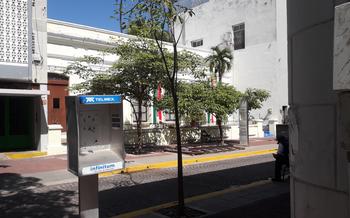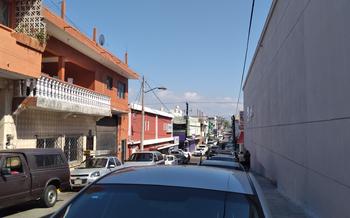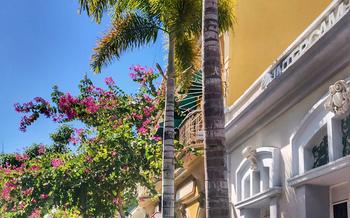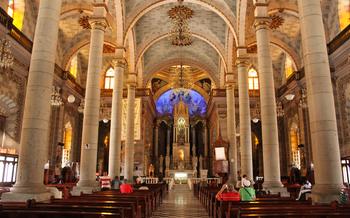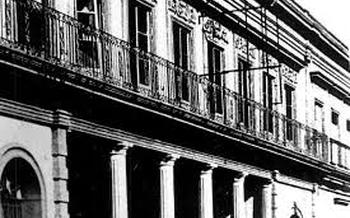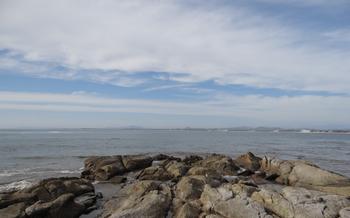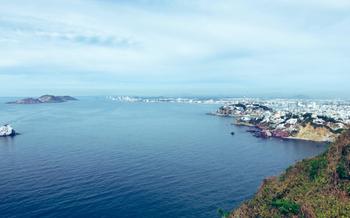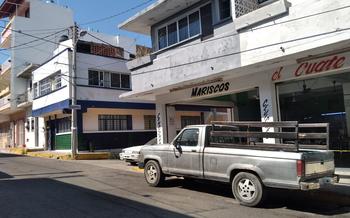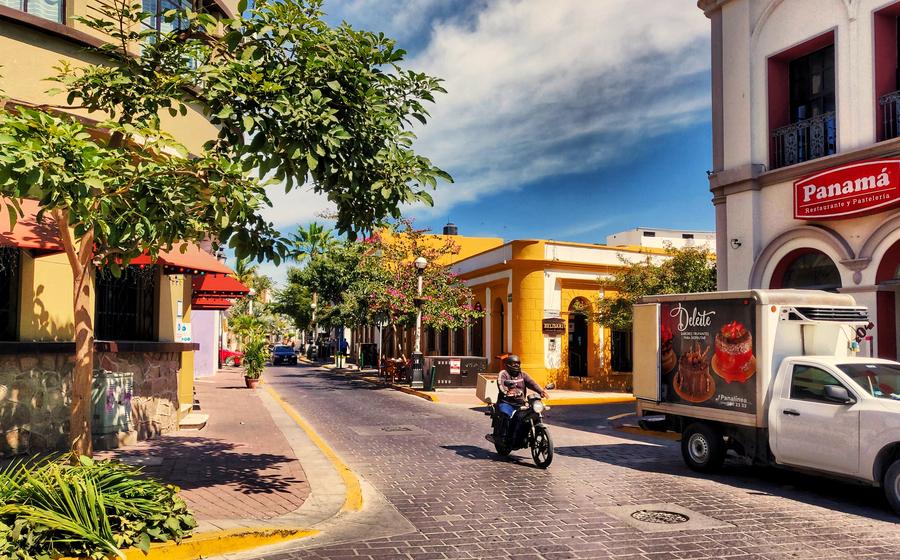
Escuela Náutica Mercante de Mazatlán
- The Museum: A Treasure Trove of Maritime History
- The Training Center: Nurturing Future Seafarers
- Student Life: Camaraderie and Discipline
- The Fleet: A Symbol of Pride
- The Observatory: A Window to the Stars
- The Chapel: A Place of Reflection
- The Sports Complex: Fostering Physical Fitness
- The Cadet Corps: A Force for Discipline
- The Future of the Escuela Náutica Mercante de Mazatlán
- Tips for Visitors
- Insider Tip: A Hidden Gem
The Museum: A Treasure Trove of Maritime History
The museum at the Escuela Náutica Mercante de Mazatlán is a treasure trove of maritime history, housing a vast collection of artifacts, documents, and exhibits that tell the story of Mexico's rich seafaring heritage. Visitors can explore the museum's galleries, which are dedicated to various aspects of maritime history, including shipbuilding, navigation, and exploration.
The exhibits on display range from ancient navigational instruments to modern-day ship models, providing a glimpse into the evolution of maritime technology. Visitors can also learn about the history of Mazatlán's port and its role in the development of the city.
One of the highlights of the museum is its collection of rare books and manuscripts, which includes works by some of the most famous explorers and navigators in history. These books provide a firsthand account of the challenges and triumphs of early seafaring voyages.
Guided tours of the museum are available, providing visitors with a deeper understanding of the exhibits and their significance. The museum also offers educational programs for students and researchers, contributing to the preservation and dissemination of maritime knowledge.
The Training Center: Nurturing Future Seafarers
The Escuela Náutica Mercante de Mazatlán's training center is the heart of the school's educational mission. Here, aspiring seafarers receive the skills and knowledge necessary to navigate the world's oceans and waterways. The center offers a range of courses, from basic seamanship to advanced navigation and engineering. The school's reputation for excellence attracts students from all over Mexico and beyond.
The training facilities are state-of-the-art, providing students with hands-on experience in a realistic environment. The school's fleet of training vessels allows students to put their skills to the test on the open water. Graduates of the training center are highly sought after by shipping companies and other maritime employers, who value their rigorous training and dedication to safety.
The school's reputation as a world-class training center is built on the dedication of its faculty and staff. Instructors are experienced mariners who bring their real-world knowledge and expertise into the classroom. The school also maintains close partnerships with industry leaders, ensuring that its curriculum remains relevant and up-to-date. This combination of academic rigor and practical experience has made the Escuela Náutica Mercante de Mazatlán one of the premier maritime training institutions in the world.
Student Life: Camaraderie and Discipline
The daily routine of a cadet at the Escuela Náutica Mercante de Mazatlán is a rigorous one. They rise early for morning exercises and then attend classes in navigation, seamanship, engineering, and other maritime subjects. Afternoons are spent on practical training, either on board the school's training vessels or in the workshops and laboratories. Evenings are reserved for study and homework.
Despite the demanding schedule, cadet life is also marked by camaraderie and a strong sense of community. Cadets live together in dormitories and share meals in the school's dining hall. They participate in social activities and events, such as sports competitions, dances, and field trips. These activities help to build bonds between cadets and foster a sense of belonging.
Of course, cadet life is not without its challenges. Cadets must learn to cope with the rigors of the academic program, the demands of practical training, and the strict disciplinary code. They must also learn to work effectively as part of a team and to adapt to the unique challenges of life at sea.
Despite the challenges, most cadets find that the camaraderie and support they receive from their fellow cadets make the experience a rewarding one. The friendships they form during their time at the academy often last a lifetime.
The Fleet: A Symbol of Pride
The Escuela Náutica Mercante de Mazatlán boasts an impressive fleet of vessels that serve as a symbol of its maritime prowess and commitment to practical training. These vessels are not mere decorative pieces but play an integral role in the education and development of future seafarers.
The fleet consists of various types of vessels, including training ships, research vessels, and support boats. Each vessel is meticulously maintained and equipped with the latest technology to provide cadets with hands-on experience in navigation, ship handling, and marine engineering.
The training ships are the backbone of the fleet and are used for cadet training cruises. These cruises offer cadets the opportunity to put their theoretical knowledge into practice, learn about different cultures, and gain experience in working as part of a ship's crew.
The research vessels are used to conduct scientific research in various fields, including oceanography, marine biology, and hydrography. These vessels are equipped with state-of-the-art scientific equipment and provide cadets with the opportunity to participate in real-world research projects.
The support boats provide logistical support to the training and research vessels and are used for a variety of tasks, such as towing, diving operations, and search and rescue missions.
The school's fleet is not only used for training and research but also plays an important role in public events and exhibitions. The vessels are often showcased at maritime festivals and open days, allowing the public to admire their beauty and learn about the school's maritime heritage.
The Observatory: A Window to the Stars
The Escuela Náutica Mercante de Mazatlán is home to an impressive observatory, a facility that has played a significant role in astronomical research and education in the region. Established in the early 20th century, the observatory boasts a rich history and a collection of state-of-the-art equipment.
The observatory houses a variety of telescopes, including a large refracting telescope, which is one of the largest of its kind in Mexico. This telescope has been used to make numerous discoveries, including the observation of a previously unknown comet in 19
In addition to its research capabilities, the observatory also serves as an educational resource for students and the general public. Guided tours are offered, providing visitors with an opportunity to learn about astronomy and view the night sky through the observatory's powerful telescopes.
The observatory's research and educational activities have made it a valuable asset to the Escuela Náutica Mercante de Mazatlán and the broader scientific community. It continues to be a hub for astronomical research and education, inspiring future generations of scientists and astronomers.
The Chapel: A Place of Reflection
The Escuela Náutica Mercante de Mazatlán boasts a beautiful chapel that serves as a spiritual haven for cadets, staff, and visitors. Constructed in the early 20th century, the chapel showcases stunning architecture, featuring intricate stained-glass windows depicting maritime scenes. Its serene ambiance provides a sanctuary for contemplation and reflection.
Throughout the week, religious services are held in the chapel, allowing cadets and staff to come together for worship and prayer. Special events, such as Christmas mass and Easter services, are also celebrated with grandeur and devotion. The chapel's acoustics are particularly noteworthy, making it an ideal venue for choral performances and concerts.
Beyond its religious significance, the chapel holds a special place in the hearts of cadets. It is a place where they can find solace and strength during challenging times. Here, they can seek guidance and inspiration as they prepare for their future careers at sea. The chapel serves as a constant reminder of the importance of faith and spirituality in their lives.
The Sports Complex: Fostering Physical Fitness
The Escuela Náutica Mercante de Mazatlán recognizes the importance of physical fitness in maritime training. To that end, the school has developed a comprehensive sports complex that provides cadets with access to a wide range of sports and activities. The complex features a state-of-the-art gymnasium equipped with modern fitness equipment, as well as outdoor facilities for team sports such as soccer, volleyball, and basketball.
In addition to promoting physical fitness, the sports complex also serves as a venue for social interaction and team building. Cadets from different classes and backgrounds come together to compete in friendly matches, fostering a sense of camaraderie and teamwork. The complex also hosts regular sports tournaments and competitions, which provide cadets with an opportunity to showcase their skills and compete against their peers.
The school's commitment to physical fitness extends beyond the cadet corps. The sports complex is also open to the local community, providing residents of Mazatlán with access to affordable sports facilities and programs. This initiative not only promotes healthy living but also strengthens the school's ties to the community it serves.
The Escuela Náutica Mercante de Mazatlán's sports complex is a testament to the school's commitment to providing its cadets with a well-rounded education. By emphasizing the importance of physical fitness, the school prepares its students for the rigors of a career at sea, while also promoting teamwork, camaraderie, and a healthy lifestyle.
The Cadet Corps: A Force for Discipline
The Escuela Náutica Mercante de Mazatlán maintains a strict disciplinary code enforced by the cadet corps, a student-led organization that plays a crucial role in upholding the school's values and traditions. The corps is responsible for maintaining order and discipline among the cadets, ensuring they adhere to the school's regulations and standards of conduct.
The cadet corps is structured hierarchically, with senior cadets holding positions of leadership and responsibility. These senior cadets are responsible for mentoring and guiding their juniors, setting an example of professionalism and discipline. They also conduct regular inspections of cadets' quarters, uniforms, and personal appearance to ensure compliance with the school's standards.
The cadet corps is not just a disciplinary body but also a platform for leadership training and development. Senior cadets are given the opportunity to lead and manage teams, make decisions, and resolve conflicts, preparing them for future leadership roles in the maritime industry.
The cadet corps fosters a sense of camaraderie and teamwork among the students. Cadets work together to maintain the school's high standards, support each other through challenging training exercises, and create a strong sense of community. The cadet corps is a valuable asset to the school, helping to instill discipline, leadership, and teamwork in future seafarers.
The Future of the Escuela Náutica Mercante de Mazatlán
The Escuela Náutica Mercante de Mazatlán is constantly evolving to meet the changing demands of the maritime industry. The school has ambitious plans for expansion and development, including the construction of new training facilities, the acquisition of modern vessels, and the expansion of its academic offerings.
One of the key challenges facing the school is the need to adapt to the increasing automation and digitalization of the maritime industry. The school is investing in new technologies and training programs to ensure that its graduates are equipped with the skills they need to succeed in the modern maritime workplace.
Despite the challenges, the Escuela Náutica Mercante de Mazatlán is well-positioned for continued success. The school has a strong reputation for academic excellence and a long history of preparing students for successful careers in the maritime industry. The school is also committed to providing its students with a well-rounded education that emphasizes not only technical skills but also leadership, teamwork, and ethical decision-making.
The school's role in the future of maritime education is crucial. The school is a leader in the field of maritime education and training, and its graduates are in high demand by employers around the world. The school is committed to providing its students with the skills and knowledge they need to lead the maritime industry into the future.
Tips for Visitors
Planning a visit to the Escuela Náutica Mercante de Mazatlán is a rewarding experience for anyone interested in maritime history and education. Here are some tips to make the most of your visit:
Plan Your Visit: - Check the school's website for visiting hours and any special events or exhibitions. - Plan to spend at least two to three hours exploring the campus, museum, and library.
Guided Tours and Reservations: - Guided tours are available for groups upon request. Advance reservations are recommended to ensure availability. - For individual visitors, self-guided tours are also an option, and brochures and maps are provided at the entrance.
Accessibility and Facilities: - The campus is wheelchair accessible, and visitors with disabilities are welcome. - Parking is limited, so it's advisable to arrive early or use public transportation. - Restrooms and a cafeteria are available for visitors' convenience.
Respect School Regulations: - Remember that the Escuela Náutica Mercante de Mazatlán is an active educational institution. - Be respectful of the students and staff, and follow any rules or regulations posted on the campus.
Insider Tip: A Hidden Gem
Beyond the classrooms and training facilities, the Escuela Náutica Mercante de Mazatlán holds a hidden gem that often goes unnoticed by visitors. Tucked away in a quiet corner of the campus, the school's maritime museum houses a remarkable collection of artifacts, models, and documents that trace the rich history of seafaring in the region.
To access this treasure trove of maritime heritage, visitors can inquire at the school's main office for directions and permission to enter. Once inside, they will be greeted by a dedicated curator who will guide them through the exhibits and share fascinating stories about the school's past and the role it has played in shaping the maritime landscape of Mexico.
Among the highlights of the collection are intricate models of historic sailing ships, antique navigational instruments, and rare charts that reveal the daring voyages undertaken by Mazatlán's seafaring pioneers. Visitors can also marvel at a collection of uniforms, medals, and personal belongings that belonged to distinguished alumni who went on to become renowned captains, admirals, and explorers.
This hidden gem offers a unique glimpse into the world of maritime education and the rich traditions of seafaring that have been nurtured at the Escuela Náutica Mercante de Mazatlán for over a century. It is a must-visit for anyone interested in maritime history, culture, and the enduring legacy of this venerable institution.
